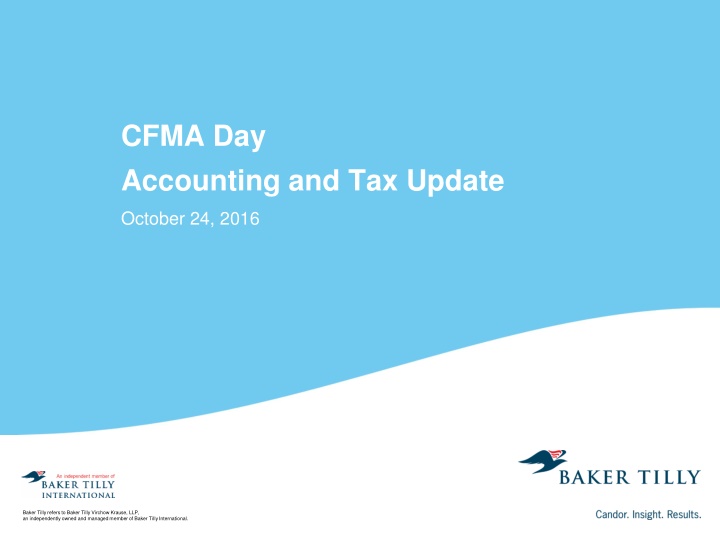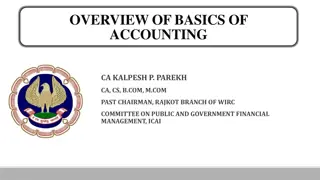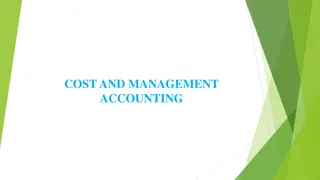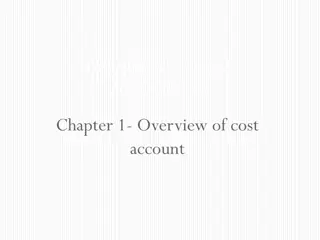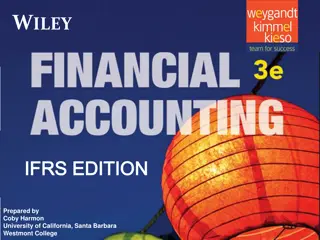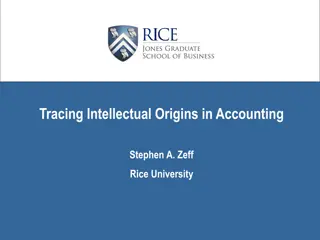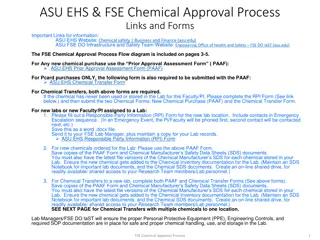Accounting Standards Update ASU 2014-09 Overview
The Accounting Standards Update ASU 2014-09, Topic 606, focuses on Revenue from Contracts with Customers. It provides a comprehensive standard for revenue recognition, aiming to improve comparability and transparency across industries. The update outlines a five-step model for revenue recognition, emphasizing the identification of performance obligations and proper revenue allocation. Effective for annual reporting periods starting after December 15, 2018, the ASU supersedes previous guidance and encourages international convergence for better market understanding.
Download Presentation

Please find below an Image/Link to download the presentation.
The content on the website is provided AS IS for your information and personal use only. It may not be sold, licensed, or shared on other websites without obtaining consent from the author.If you encounter any issues during the download, it is possible that the publisher has removed the file from their server.
You are allowed to download the files provided on this website for personal or commercial use, subject to the condition that they are used lawfully. All files are the property of their respective owners.
The content on the website is provided AS IS for your information and personal use only. It may not be sold, licensed, or shared on other websites without obtaining consent from the author.
E N D
Presentation Transcript
CFMA Day Accounting and Tax Update October 24, 2016 Baker Tilly refers to Baker Tilly Virchow Krause, LLP, an independently owned and managed member of Baker Tilly International.
Accounting Update Accounting Standards Update No. 2014-09 (Topic 606) Revenue from Contracts with Customers
Accounting Standards Update Accounting Standards Update ( ASU ) No. 2014-09, (Topic 606) Revenue from Contracts with Customers Effective for annual reporting periods for private companies beginning after December 15, 2018 Retrospective application for comparative financial statements (December 31, 2019 and 2018). Modified retrospective application for current period presentation only (December 31, 2019) with additional disclosures for impact to results in the prior period. Why did the FASB issue the Accounting Standards Update? Revenue is probably the most important line item in an entity s financial statements. Revenue recognition practices diverged across industries due to a lack of a comprehensive standard. The standard would improve comparability and transparency as to how entities recognize revenue. International convergence would be beneficial for capital markets Supersedes Current Guidance Topic 605 (Revenue Recognition) and most industry specific guidance Some cost accounting guidance in Topic 605-35 (Revenue Recognition-Construction-Type and Production-Type Contracts
Topic 606 Revenue from Contracts with Customers Provides a five step model for Revenue Recognition Step 1 Identify the contract with the customer Step 2 Identify the separate performance obligations in each contract Step 3 Determine the transaction price of each contract Step 4 Allocate the transaction price to the separate performance obligations in each contract Step 5 Recognize revenue when (or as) the entity satisfies the separate performance obligations in each contract
Topic 606 Revenue from Contracts with Customers (continued) Performance Obligation A promise in a contract with a customer to transfer to the customer either: A good or service (or bundle of goods and services) that is distinct A series of distinct goods or services that are substantially the same and that have the same pattern for transfer to the customer Probable The future event or events are likely to occur Revenue Inflows or other enhancements of assets of an entity or settlements of its liabilities ( or a combination of both) from delivering or producing goods, rendering services, or other activities that constitutes the entity s ongoing major or central operations Standalone Selling Price The price at which an entity would sell a promised good or service separately to a customer Transaction Price The amount of consideration to which an entity expects to be entitled in exchange for transferring promised goods or services to a customer, excluding amounts collected on behalf of third parties
Topic 606 Revenue from Contracts with Customers (continued) Additional analysis of Step 1: Identify the contract with the customer Separate Contract If a change order is distinct and has a stand-alone price, it is considered a new contract and accounted for as a separate performance obligation. Termination of the Original Contract and Creation of a New Contract Applies when the remaining goods or services to be provided are distinct from those transferred prior to the change order. The revenue recognized to date on the original contract is not adjusted. The remaining consideration from the original contract and consideration under the change order are combined to create a new contract where the transaction price will be accounted for prospectively and allocated to remaining performance obligations. Part of the Original Contract If a change order is a continuation of the original contract and the goods and services are not distinct from the existing contract, the modification is accounted for as a cumulative catch up adjustment to revenue previously recognized at the date of the change order, as if the change order had been in place from the inception of the contract.
Topic 606 Revenue from Contracts with Customers (continued) Additional analysis of step 2: Identify separate performance obligations Performance Obligation A promise to deliver a good or provide a service To identify performance obligations, a company needs to determine whether or not the goods or services are distinct Distinct A customer can benefit from the good or service on its own The good or service is separable from the other goods or services in a contract Not Distinct The good or service is highly interdependent and interrelated It significantly modifies or customizes other goods or services in a contract, and The company provides a significant integration service The majority of construction contracts provide goods or services that are highly interdependent and interrelated, which would be considered one performance obligation.
Topic 606 Revenue from Contracts with Customers (continued) Step 3: Determining Transition Price Transaction Price The amount of consideration a company expects to be entitled to in exchange for satisfying its performance obligation The transaction price is, generally, the contract price under the terms of the contract and may include fixed amounts, variable amounts, or both Variable consideration (i.e., change orders, claims, or other incentives/awards that are unknown at contact inception) is accounted for using either the expected value approach or the most likely amount approach Amounts are only included in the transaction price if it is probable that a significant reversal in the amount of cumulative revenue recognized will not occur in the future In U.S. GAAP, probable generally means at least a 75% chance of occurring.
Topic 606 Revenue from Contracts with Customers (continued) Step 3 considerations Variable consideration Expected Value Approach The sum of probability-weighted estimates over a range of possible outcomes/consideration amounts An expected value may be an appropriate estimate of the amount of variable consideration if an entity has a large number of contracts with similar characteristics Most Likely Amount Approach The single most likely amount in a range of possible consideration amounts (that is, the single most likely outcome of the contract) The most likely amount may be an appropriate estimate of the amount of variable consideration if the contract has only two possible outcomes (for example, an entity either achieves a performance bonus or does not).
Topic 606 Revenue from Contracts with Customers (continued) Step 3 considerations Variable consideration (continued) The method used is not a free choice; rather it is driven by the facts and circumstances inherent in the contract, and requires documentation of management s conclusions The chosen method should be applied consistently throughout the contract and throughout contracts with similar terms Either approach requires management to re-evaluate the variable consideration at each reporting period to determine if the estimate is still valid based on the current facts and circumstances
Topic 606 Revenue from Contracts with Customers (continued) Step 4 Allocate Transaction Price to Performance Obligations When one or more performance obligations are present, the transaction price is allocated to each performance obligation based upon an estimate of the stand-alone selling prices of goods and services Example: A contractor has a contract to build a hospital and a parking garage for a total contract price of $150 million. If the hospital and parking garage are considered separate performance obligations, an estimate of the price of each stand-alone project needs to be determined: $130 million for the hospital and $30 million for the parking garage, for a total of $160 million on a stand-alone basis. The contract price would be allocated as follows: Hospital: ($130M / $160M) * $150M = $121.875M Parking Garage: ($30M / $160M) * $150M = $28.125M If a stand-alone selling price is not directly observable for any of the identified performance obligations, the company should utilize estimates.
Topic 606 Revenue from Contracts with Customers (continued) Step 4 Allocate Transaction Price to Performance Obligations (continued) The standard describes three suitable methods for determining stand alone selling price, but does not require their use if a more suitable method is available with more observable inputs: Adjusted Market Assessment Price is based on what a customer would be willing to pay in the market in which the goods and services are being sold (competitor pricing adjusted for the entity s costs and margins) Expected Cost Plus a Margin Price is determined by forecasting the expected costs of satisfying a performance obligation and then adding an appropriate margin for the good or service Residual Estimate the stand alone selling price by reference to the total transaction price less the sum of observable standalone selling prices for other goods or services promised in the contract (The residual method may be used only if the selling price is highly variable because a stand alone selling price is not discernible or a price for the good or service has not yet been established)
Topic 606 Revenue from Contracts with Customers (continued) Step 5 Recognize Revenue When (or as) Performance Obligations are Satisfied Satisfaction of performance obligations occurs when control of the good or service transfers to the customer The transfer of control can occur over time or at a point in time Control is transferred over time when at least one of the following criteria is met: A customer receives and consumes the benefits of the performance as the work is performed The contractor s performance creates or enhances a customer-controlled asset An asset with an alternative use to the contractor is not created but the contractor has a right to payment for performance completed to date A performance obligation is satisfied at a point in time if it does not meet the criteria above
Topic 606 Revenue from Contracts with Customers (continued) Step 5 Recognize Revenue When (or as) Performance Obligations are Satisfied (continued) Under the new standard, measuring progress towards completion is performed using one of the following methods: Input Method Recognize revenue on the basis of the contractor s efforts or inputs to the satisfaction of a performance obligation, such as labor hours, labor dollars, machine hours, costs incurred, or material quantities used, relative to the total expected inputs to the satisfaction of that performance obligation Output Method Recognize revenue on the basis of direct measurement of the value to the customer of goods or services transferred to date relative to the remaining goods or services promised under the contract. Examples include: surveys of goods or services transferred to date, appraisals of results achieved, milestones reached, or units produced or delivered.
Topic 606 Revenue from Contracts with Customers (continued) Step 5 Recognize Revenue When (or as) Performance Obligations are Satisfied (continued) Note: Costs incurred related to rework or wasted materials would be excluded from input measurement, as these costs do not represent the transfer of goods or services to the customer. For construction contractors, the majority of performance obligations will be measured over time as control is transferred using the input method. This is consistent with the percentage of completion method under current U.S. GAAP.
Topic 606 Revenue from Contracts with Customers (continued) Thoughts on implementation Internal controls will be critical the proper information needs to be gathered Operations personnel will need to be educated and involved Consider developing a process checklist for each project file Accounting at the general ledger and job cost level: Some systems do not support phase or element job costing Systems generally do not provide for allocation of activities to two or more phases (performance obligations) Systems generally do not have processes available to measure the contract asset / liability at the performance level and then combine it at the contract level before adjusting the balance sheet Development of a process for tracking the difference between revenue recognized under the new standard and the amount recognized for tax purposes will be needed
Accounting Update Accounting Standards Codification 842 Leases
Accounting Standards Codification 842 Leases Definition of a lease Under ASC 842, an agreement contains a lease if the lessee has both: The right to obtain substantially all of the economic benefits from the use of an identified asset, and The right to direct the use of such asset
Accounting Standards Codification 842 Leases Definition of a lease (continued) An agreement does not contain a lease if the contract permits the supplier to substitute one asset for another and that right is substantive. A supplier s right is considered substantive if both of the following exist: The supplier has the practical ability to substitute alternative assets throughout the period of the use The supplier would benefit economically from the exercise of its right to substitute the asset
Accounting Standards Codification 842 Leases Definition of a lease (continued) A contract that contains a lease may include other components as well. A lease contains a separate component if the following conditions are met: The lessee can benefit from the right of use either on its own or together with other resources that are readily available to the lessee The right of use is neither highly dependent on nor highly interrelated with the other right(s) to use underlying assets in the contract A contract that includes land as well as other assets must be separated with the right to use the land as a separate component
Accounting Standards Codification 842 Leases Definition of a lease (continued) If the contract contains separate components, then the lessee must allocate the consideration specified in the lease as follows: The customer shall determine the standalone selling price of the components based on observable prices; if observable prices are not available, the lessee shall estimate the standalone price maximizing the use of observable information The lessee shall allocate the consideration based on the standalone selling prices The standard provides a practical expedient whereby the customer need not account for the components separately if it makes an accounting policy election to treat the components as one lease obligation
Accounting Standards Codification 842 Leases Lease classification Currently leases are classified as either: Operating leases No balance sheet impact Periodic lease payments are expensed as incurred Capital leases Leased assets are capitalized and a corresponding lease liability is recognized Amortization and interest expense is recognized periodically
Accounting Standards Codification 842 Leases Lease classification (continued) Under the new lease standard, leases will be classified as either: Operating leases Right to use asset and corresponding lease liability recognized on the balance sheet Rent expense recognized on a straight-line basis through amortization of the asset and accretion of the lease liability Finance leases Right to use asset and corresponding lease liability recognized on the balance sheet Amortization and interest expense is recognized periodically
Accounting Standards Codification 842 Leases Lease classification (continued) A lease will qualify as a finance lease if it meets any of the following: Transfer of ownership Purchase option that is reasonably certain to be exercised Lease term for major part of the remaining economic life Present value of the sum of the lease payments equals or exceeds substantially all of the fair value of the asset The underlying asset is of such a specialized nature that it is expected to have no alternative use to the lessor at the end of the lease term Guidance is relatively consistent with that existing for capital leases
Accounting Standards Codification 842 Leases Additional considerations Companies will need to consider the following for implementation: Effective date Public years beginning after December 15, 2018 Nonpublic years beginning after December 15, 2019 Transition requirements Retroactively applied to earliest period presented Internal controls over financial reporting Systems and tracking of asset and liability balances Debt covenants
Accounting Standards Codification 842 Leases Additional considerations (continued) Companies will need to consider the following for implementation: Accounting policy elections practical expedients: Transition requirements Lease components Leases less than one-year o Considerations for renewals Discount rate Initial direct costs Lease modifications New contract Modification to the initial contract
Compensation Social Security wage base to increase in 2017 from $118,500 to $127,200 7% increase; 2016 was unchanged from 2015 Chief Counsel Advice 201640014 LLC members subject to SE tax on all income and not just guaranteed payments Consider a disclosure on the tax return if you take a contrary position IRS Exam experience: ALL compensation is subject to either employment tax or SE tax Consistent with IRS position in the CCA 28
Debt v. Equity Final and Temp Regulations issued October 12, 2016 Binding on taxpayers Taking positions contrary to the regs requires a Form 8275R One goal is to prohibit use of loans to increase basis Recommendations for loans: Must have a note Should have monthly payments but at least an annual payment; stay away from balloon notes Accrue interest on the note at an arm s length interest rate Keep records and tax returns forever 29
Taxpayer Identity Theft Bogus K-1s followed by bogus 1040s Respond right away to IRS notices Fake CP2000 (Matching) notices Request payments of smaller dollar amounts, e.g., $789 Requests payments to IRS (legitimate CP2000 notices request payment to the United States Treasury) 30
Possible Post-Election Changes If Clinton wins Taxes may increase for corporate entities and partnerships Contractor favorable rules that lead to deferral of tax likely to be reviewed; think bonus depreciation and similar items If Trump wins Unlikely any change to contractor or real estate rules 31
Tax Update Unclaimed Property: The Time to Act Is Now
Overview Unclaimed property basics Two Important Federal Court Decisions in 2016 Temple-Inland bombshell and what it means Bed Bath and Beyond How to assess my company s liability? VDAs 33
Unclaimed Property Basics Definition: Any intangible personal property that is held, issued, or owed in the ordinary course of business and has remained unclaimed by the apparent owner for a specified period of time after it became payable or distributable. ALL states have unclaimed property laws: 54 different jurisdictions have enacted unclaimed property laws Unclaimed property reporting is mandatory States have the ability to charge penalty and interest for noncompliance some states charge officers Extensive lookback period for nonfilers No de minimus amounts. Some states require negative reporting 34
Unclaimed Property Basics Property types to consider (not an all-inclusive list) Accounts receivable credit balances Accounts payable Payroll Commissions Refund accounts Gift certificates Security deposits Insurance claim payment Dividends Shares of stock Safety deposit box Utility deposits Savings accounts Workers compensation 35
Unclaimed Property Basics Which state gets the money? In 1965, the US Supreme Court (Texas v. New Jersey) decided that unclaimed property obligations must be reported and remitted to the state of the last known address of the owner (the entity to which the check/property/credit is owed) in your records. This means due diligence and reporting obligations are NOT dependent upon whether your company does business or is licensed to do business in a particular state. The last known address of your customer (the owner) controls where and how unclaimed property is reported and remitted. Primary state v. secondary state: Pennsylvania v. Delaware US Supreme Court case will revisit the discussion started with Travelers Express Co. v. Minnesota. 36
Temple-Inland, Inc. v. Cook U.S. Federal District Court District of DE. Decided: June 28, 2016 Facts: T.I. = manufacturing company in TX with nationwide ops (inc in DE) T.I. had historically filed unclaimed property reports but did not retain records indefinitely. Record retention policy was 10 years. T.I. had unclaimed property reports consistent with its record retention policy; T.I. had unclaimed property reports from 2002 DE s third party auditor, Kelmar, began audit in Dec 2008. Years under audit 1986 2007. T.I. was unable to remediate 4 A/P checks totaling approx. $4,500 and a payroll check for $800. DE estimates liability to be $2,128,834.13 for years where records were unavailable, dating back 22 years. 37
Temple-Inland, Inc. v. Cook Holding: DE s estimation practices are unconstitutional; violation of Substantive Due Process Estimation is legal, but it must be reasonable. DE s estimations shocked the conscience. RECORD RETENTION: DE failed to adopt a record retention statute, but then tried to hold T.I responsible for records. 46 states had adopted record retention statutes, but not DE. SOL was supposed to be 6 years, not 22 (failure to provide records didn t extend the SOL). No negative report filing requirement in DE. RATIO ESTIMATOR UNREASONABLE. All assumptions were in favor of a higher liability (e.g., no remediation efforts assumed, even though T.I. had a policy to reconcile/remediate). DE s CLEAR PURPOSE WAS TO RAISE REVENUE ( Unclaimed property was never intended to be a tax mechanism whereby states can raise revenue as needed for the general welfare. ) 38
Temple-Inland, Inc. v. Cook What does it mean? Good facts get a good result (T.I. filed reports, kept records, and made affirmative efforts to remediate). Without these facts, the result would be worse. States (and 3rd party Auditors) are incredibly aggressive. Estimation techniques must be reasonable! Exercise caution when destroying records (tax returns and unclaimed property reports (46 states have record retention statutes, typically 5-10 years; 15 years was highest, 3 years was lowest). Nobody wins in these cases expensive to go to district court; Appeals process. Avoid the high fees VDA and compliance is best. 39
Bed Bath & Beyond, Inc. v. Chiang California Superior Court (CA trial court) Decided: March 4, 2016 Facts: BB&B files refund claim for previously-escheated Merchandise Return Credits ( MRCs ) MRCs: Issued to customers who return items but have no receipt Not redeemable for cash No expiration CA rejects refund claim under the theory that MRCs are NOT gift certificates (CA law exempts gift certs from escheat). 40
Bed Bath & Beyond, Inc. v. Chiang Holdings MRCs ARE GIFT CERTIFICATES. They bear the same characteristics as more traditional gift certificate. Although not obtained for purposes of gifting to another, the law recognizes them as gift certificates. MRCs ARE NOT INTANGIBLE PERSONAL PROPERTY No property is actually owed to anyone so there is no liability for intangible personal property. 41
Bed Bath & Beyond, Inc. v. Chiang What does it mean? We are in the Wild West (what the heck do we have?!) States won t go down without a fight: CA will Appeal Laws can vary greatly from state to state [jurisdiction will control] CA exempts gift certificates (others may not) CA defines gift certificates (others may not) 42
How to assess my companys liability? Determining your liability: Documents to gather/review Corporate structure Annual reports Current and previous charts of accounts General ledger trial balances Prior unclaimed property report/audit activity O/S check listings of all disbursement accounts Accounts receivable aging report Journal entries related to write-offs (e.g., previously voided checks) Descriptions and contracts related to programs administered by third party Merger and acquisition documents 43
How to assess my companys liability? Review applicable state statutes to determine exemptions, deductions, property types, and unclaimed property definitions. Common examples: Business to business (B2B) Payroll exemptions (Kentucky, Michigan, and Ohio) Administrative exemptions (Texas) Gift card exemptions 44
How to assess my companys liability? Your clients may not need to escheat Take the money into income Owner s confirmation that the property is theirs (Reunite) Current, ongoing business relationship between owners and holders (Resolve, potentially income) Duplicate property issued in owner s name in error (Income) Owner s confirmation that property satisfied by other means (Income) 45
Voluntary disclosure agreements What is a voluntary disclosure agreement (VDA)? Agreement to perform some of the following: perform due diligence, file promptly going forward, apply state laws ... generally allows for penalties and interest to be abated and in some cases the lookback period is reduced Formal vs. informal - Most states have adopted some type of voluntary disclosure program Amnesty programs - Much more formal and offered by some states on an occasional basis 46
Voluntary disclosure agreements Why seek a VDA for each state? If accepted, the benefits include: Limited lookback periods Limited audit scope Self-review Waiver of penalty in most cases Waiver of interest in most cases Closing letter security Sending all property to one state is not encouraged 47
Voluntary disclosure agreements MINNESOTA S VDA PROGRAM 10 years of reports required Estimation required if records unavailable Waiver of penalties and interest Initial letter (VDA 1) and closing letter (VDA 2) 6 months to complete program Consolidated reporting allowed 48
Voluntary disclosure agreements MINNESOTA S VDA PROGRAM PHASE 1 (Scoping): Initial review of records; meet with MN to discuss any anticipated legal interpretations PHASE 2 (Record Review): Conduct self audit. Identify initial population, which must be submitted to MN. Reconcile and remediate. PHASE 3 (Due Diligence): Send letters to owners PHASE 4 (Closing Administration): Formal closing with MN; answer questions, meet with bureaucrats. 49
Connect with us. Mark Heroux, JD Principal Tax Practice 312 729 8005 mark.heroux@bakertilly.com Matt Tredinnick, CPA Partner Construction and Real Estate Practice 612 876 4802 matt.tredinnick@bakertilly.com Scott Johnson, CPA Senior Tax Manager Construction and Real Estate Practice 612 876 4885 scott.johnson@bakertilly.com Colin Walsh, JD Senior Manager Tax Practice 312 729 8043 colin.walsh@bakertilly.com bakertilly.com/construction
